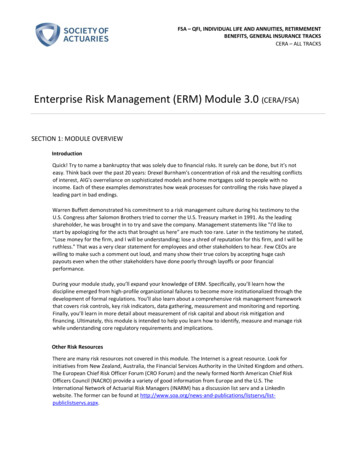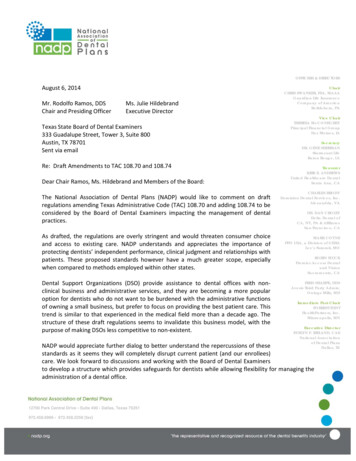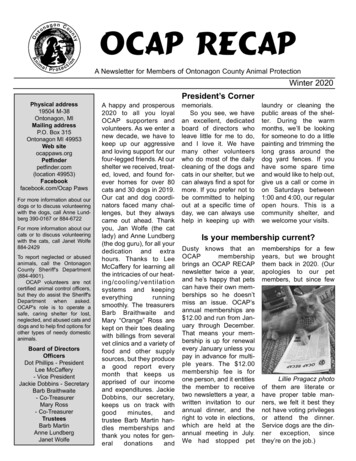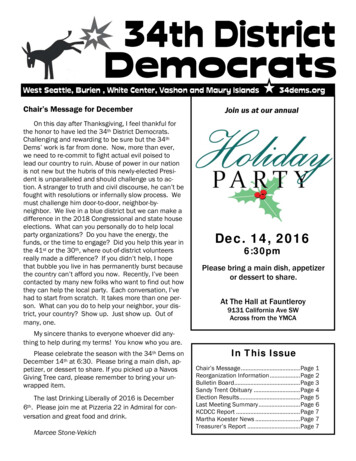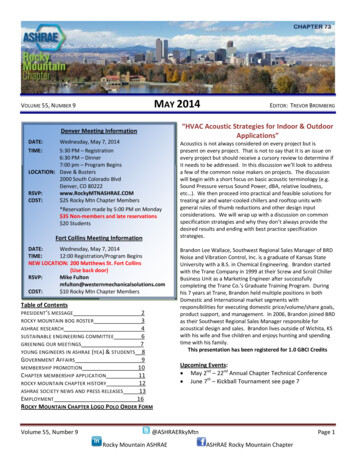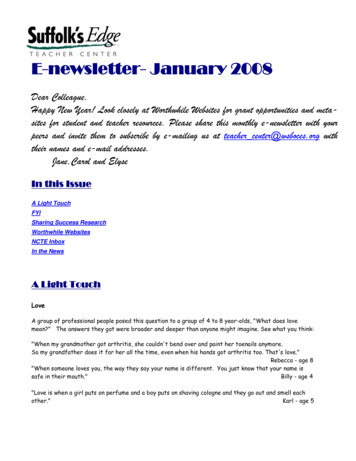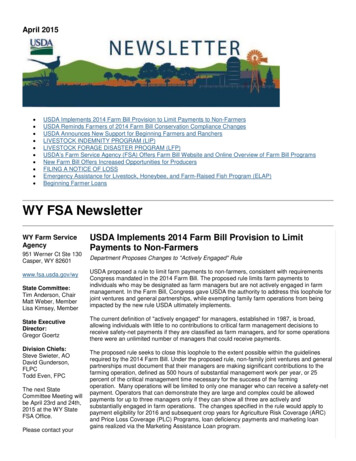
Transcription
April 2015 USDA Implements 2014 Farm Bill Provision to Limit Payments to Non-FarmersUSDA Reminds Farmers of 2014 Farm Bill Conservation Compliance ChangesUSDA Announces New Support for Beginning Farmers and RanchersLIVESTOCK INDEMNITY PROGRAM (LIP)LIVESTOCK FORAGE DISASTER PROGRAM (LFP)USDA’s Farm Service Agency (FSA) Offers Farm Bill Website and Online Overview of Farm Bill ProgramsNew Farm Bill Offers Increased Opportunities for ProducersFILING A NOTICE OF LOSSEmergency Assistance for Livestock, Honeybee, and Farm-Raised Fish Program (ELAP)Beginning Farmer LoansWY FSA NewsletterWY Farm ServiceAgency951 Werner Ct Ste 130Casper, WY 82601www.fsa.usda.gov/wyState Committee:Tim Anderson, ChairMatt Weber, MemberLisa Kimsey, MemberState ExecutiveDirector:Gregor GoertzDivision Chiefs:Steve Swieter, AODavid Gunderson,FLPCTodd Even, FPCThe next StateCommittee Meeting willbe April 23rd and 24th,2015 at the WY StateFSA Office.Please contact yourUSDA Implements 2014 Farm Bill Provision to LimitPayments to Non-FarmersDepartment Proposes Changes to "Actively Engaged" RuleUSDA proposed a rule to limit farm payments to non-farmers, consistent with requirementsCongress mandated in the 2014 Farm Bill. The proposed rule limits farm payments toindividuals who may be designated as farm managers but are not actively engaged in farmmanagement. In the Farm Bill, Congress gave USDA the authority to address this loophole forjoint ventures and general partnerships, while exempting family farm operations from beingimpacted by the new rule USDA ultimately implements.The current definition of "actively engaged" for managers, established in 1987, is broad,allowing individuals with little to no contributions to critical farm management decisions toreceive safety-net payments if they are classified as farm managers, and for some operationsthere were an unlimited number of managers that could receive payments.The proposed rule seeks to close this loophole to the extent possible within the guidelinesrequired by the 2014 Farm Bill. Under the proposed rule, non-family joint ventures and generalpartnerships must document that their managers are making significant contributions to thefarming operation, defined as 500 hours of substantial management work per year, or 25percent of the critical management time necessary for the success of the farmingoperation. Many operations will be limited to only one manager who can receive a safety-netpayment. Operators that can demonstrate they are large and complex could be allowedpayments for up to three managers only if they can show all three are actively andsubstantially engaged in farm operations. The changes specified in the rule would apply topayment eligibility for 2016 and subsequent crop years for Agriculture Risk Coverage (ARC)and Price Loss Coverage (PLC) Programs, loan deficiency payments and marketing loangains realized via the Marketing Assistance Loan program.
local FSA Office forquestions specific toyour operation orcounty.As mandated by Congress, family farms will not be impacted. There will also be no change toexisting rules for contributions to land, capital, equipment, or labor. Only non-family farmgeneral partnerships or joint ventures comprised of more than one member will be impactedby this proposed rule.Stakeholders interested in commenting on the proposed definition and changes areencouraged to provide written comments at www.regulations.gov by May 26, 2015. Theproposed rule is available at http://go.usa.gov/3C6Kk.USDA Reminds Farmers of 2014 Farm Bill Conservation ComplianceChangesThe 2014 Farm Bill implements a change that requires farmers to have a Highly Erodible Land Conservation andWetland Conservation Certification (AD-1026) on file.For farmers to be eligible for premium support on their federal crop insurance, a completed and signed AD-1026certification form must be on file with the FSA. The Risk Management Agency (RMA), through the Federal CropInsurance Corporation (FCIC), manages the federal crop insurance program that provides the modern farm safety net forAmerican farmers and ranchers.Since enactment of the 1985 Farm Bill, eligibility for most commodity, disaster, and conservation programs has beenlinked to compliance with the highly erodible land conservation and wetland conservation provisions. The 2014 Farm Billcontinues the requirement that producers adhere to conservation compliance guidelines to be eligible for most programsadministered by FSA and NRCS. This includes most financial assistance such as the new price and revenue protectionprograms, the Conservation Reserve Program, the Livestock Disaster Assistance programs and Marketing AssistanceLoans and most programs implemented by FSA. It also includes the Environmental Quality Incentives Program, theConservation Stewardship Program, and other conservation programs implemented by NRCS.Many FSA and Natural Resource Conservation (NRCS) programs already have implemented this requirement andtherefore most producers should already have an AD-1026 form on file for their associated lands. If an AD-1026 formhas not been filed or is incomplete, then farmers are reminded of the deadline of June 1, 2015.When a farmer completes and submits the AD-1026 certification form, FSA and NRCS staff will review the associatedfarm records and outline any additional actions that may be required to meet the required compliance with theconservation compliance provisions.FSA recently released a revised form AD-1026, which is available at USDA Service Centers and online at:www.fsa.usda.gov . USDA will publish a rule later this year that will provide details outlining the connection ofconservation compliance with crop insurance premium support. Producers can also contact their local USDA ServiceCenter for information. A listing of service center locations is available at offices.usda.gov.USDA Announces New Support for Beginning Farmers and RanchersDepartment Implementing New Farm Bill Programs, Unveiling New Centralized Online Resource to Support NextGeneration of FarmersUSDA has announced the implementation of new Farm Bill measures and other policy changes to improve the financialsecurity of new and beginning farmers and ranchers. USDA also unveiled www.USDA.gov/newfarmers, a new websitethat will provide a centralized, one-stop resource where beginning farmers and ranchers can explore the variety of USDAinitiatives designed to help them succeed.USDA’s www.usda.gov/newfarmers has in depth information for new farmers and ranchers, including: how to increaseaccess to land and capital; build new market opportunities; participate in conservation opportunities; select and use theright risk management tools; and access USDA education, and technical support programs. These issues have beenidentified as top priorities by new farmers. The website will also feature instructive case studies about beginning farmerswho have successfully utilized USDA resources to start or expand their business operations.
Today’s policy announcements in support of beginning farmers and ranchers include: Waiving service fees for new and beginning farmers or ranchers to enroll in the Non-Insured Crop DisasterAssistance Program (NAP) for the 2014 crop year. NAP provides risk management tools to farmers who growcrops for which there is no crop insurance product. Under this waiver, announced via an official notice to FarmService Agency offices, farmers and ranchers whom already enrolled in NAP for the 2014 crop year and certifiedto being a beginning farmer or social disadvantaged farmer are eligible for a service fee refund. Eliminating payment reductions under the Conservation Reserve Program (CRP) for new and beginning farmerswhich will allow routine, prescribed, and emergency grazing outside the primary nesting season on enrolled landconsistent with approved conservation plans. Previously, farmers and ranchers grazing on CRP land weresubject to a reduction in CRP payments of up to 25 percent. Waiving these reductions for new and beginningfarmers will provide extra financial support during times of emergency like drought and other natural disasters. Increasing payment rates to beginning farmers and ranchers under Emergency Assistance for Livestock,Honeybees and Farm-Raised Fish Program (ELAP). Under this provision, beginning farmers can claim up 90percent of losses for lost livestock, such as bees, under ELAP. This is a fifty percent increase over previouslyavailable payment amounts to new and beginning farmers.In the near future, USDA will also announce additional crop insurance program changes for beginning farmers andranchers – including discounted premiums, waiver of administrative fees, and other benefits.Additional information about USDA actions in support of beginning farmers and ranchers is available here.LIVESTOCK INDEMNITY PROGRAM (LIP)The Livestock Indemnity Program (LIP) provides assistance to eligible producers for livestock death losses in excess ofnormal mortality due to adverse weather and attacks by animals reintroduced into the wild by the federal government orprotected by federal law. LIP compensates livestock owners and contract growers for livestock death losses in excess ofnormal mortality due to adverse weather, including losses due to hurricanes, floods, blizzards, wildfires, extreme heat orextreme cold.For 2015, eligible losses must occur on or after Jan. 1, 2015, and before December 31, 2015. Two things must be donein order to have a completed LIP application:1)Notice of Loss:A Notice of Loss must be filed with FSA within 30 days of when the loss of livestock is apparent. Documentationis not required to report an event that kills your livestock. You may call the event into the county office or reportthe event in person. A signature is not required to report an event but the event must be reported timely afterthe death losses are discovered.2)Application for Payment:Participants must provide the following types of supporting documentation to their local FSA office when filingan Application for Payment. Applications for Payment must be filed no later than 30 calendar days after the endof the calendar year for which benefits are requested. Documentation required to file an application for paymentincludes the following examples:* Verifiable proof of death documentation.* “Verifiable” means documents from an uninterested 3rd party.Example: Veterinarian records, official 3rd Party Verification (call your local office for this form), etc.* Reliable proof of death documentation if verifiable death documentation is not available.* “Reliable” means documents provided by a producer personally or from other parties with direct interest in theoperation.
Example: Documents such as contemporaneous diaries or calendars notating dates that livestock arefound dead, dated photographs of dead livestock. These* Copy of growers contracts (if applicable)* Proof of normal mortality documentation (verifiable or reliable)* Verifiable proof of beginning or ending inventory records.* “Verifiable” inventory records means records from an uninterested party such as banking records, 3rd partytrucking records, pregnancy checks records from a veterinarian, vaccine bills, shearing records from professionalshearers, other records to support numbers claimed as beginning inventory that are from an uninterested party.Note: LIP records from immediate prior year claims can be used if you also provide acceptable records to supportchanges in inventory at the end of the prior year. Example: Sales or purchase records on adults, lambs, calves, kidsbetween prior and current year.USDA has established normal mortality rates for each type and weight range of eligible livestock, i.e. Adult Beef Cow 2.0% and Non-Adult Beef Cattle (less than 400 pounds) 4.3%. These established percentages reflect losses that areconsidered expected or typical under “normal” conditions. Producers who suffer livestock losses in 2015 must file both ofthe following: A notice of loss the earlier of 30 calendar days of when the loss was apparent or by January 30, 2016 An application for payment by January 30, 2016.Additional Information about LIP is available at your local FSA office or online at: www.fsa.usda.gov.LIVESTOCK FORAGE DISASTER PROGRAM (LFP)Currently there are no Wyoming counties eligible to apply for 2015 Livestock Forage Disaster Program (LFP) benefits,however the south central portion of the state is beginning to see some D2 ratings that could trigger eligibility if thedrought intensity continues. All Wyoming FSA Offices are watching the US Drought Monitor and will notify any countyimmediately if they become eligible for the 2015 LFP.LFP provides compensation to eligible livestock producers who suffer grazing losses for covered livestock due to droughton privately owned or cash leased land or fire on federally managed land.County committees can only accept LFP applications after notification is received by the National Office of qualifyingdrought or if a federal agency prohibits producers from grazing normal permitted livestock on federally managed landsdue to qualifying fire.For 2015 and subsequent years, eligible livestock producers must complete a CCC-853 and the required supportingdocumentation no later than 30 calendar days after the end of the calendar year in which the grazing lossesoccurred. Losses must occur in the calendar year the application is being filed.Additional Information about LFP, including eligible livestock and fire criteria, is available at your local FSA office oronline at: www.fsa.usda.gov.USDA’s Farm Service Agency (FSA) Offers Farm Bill Website and OnlineOverview of Farm Bill ProgramsThe Agricultural Act of 2014 (the Act), also known as the 2014 Farm Bill, was signed by President Obama on Feb. 7,2014. The Act repeals certain programs, continues some programs with modifications, and authorizes several newprograms administered by the Farm Service Agency (FSA). Most of these programs are authorized and funded through2018.For the latest on 2014 Farm Bill programs administered by FSA, please visit our Farm Bill website atwww.fsa.usda.gov/farmbill and for an FSA program overview please read, download and/or print our recently posted
FSA Farm Bill Fact Sheet titled, What’s in the 2014 Farm Bill for Farm Service Agency Customers?For more information on FSA, please contact your local USDA Service Center or visit us online at www.fsa.usda.gov.New Farm Bill Offers Increased Opportunities for ProducersThe 2014 Farm Bill offers increased opportunities for producers including farm loan program modifications that createflexibility for new and existing farmers. A fact sheet outlining modifications to the U.S. Department of Agriculture’s(USDA) Farm Service Agency (FSA) Farm Loan Programs is available here.The Farm Bill expands lending opportunities for thousands of farmers and ranchers to begin and continue operations,including greater flexibility in determining eligibility, raising loan limits, and emphasizing beginning and sociallydisadvantaged producers.Changes that will take effect immediately include: Elimination of the 15 year term limit for guaranteed operating loans. Modification of the definition of beginning farmer, using the average farm size for the county as a qualifierinstead of the median farm size. Modification of the Joint Financing Direct Farm Ownership Interest Rate to 2 percent less than regular DirectFarm Ownership rate, with a floor of 2.5 percent. Previously, the rate was established at 5 percent. Increase of the maximum loan amount for Direct Farm Ownership Down Payment Loan Program from 225,000to 300,000. Elimination of rural residency requirement for Youth Loans, allowing urban youth to benefit. Debt forgiveness on Youth Loans, which will not prevent borrowers from obtaining additional loans from thefederal government. Increase of the guaranteed percentage on Conservation Loans from 75 to 80 percent and 90 percent for sociallydisadvantaged borrowers and beginning farmers. Microloans will not count toward direct operating loan term limits for veterans and beginning farmers.Additional modifications must be implemented through the rulemaking processes. Visit the FSA Farm Bill website fordetailed information and updates to farm loan programs.FILING A NOTICE OF LOSSThe CCC-576, Notice of Loss, is used to report failed acreage and prevented planting and may be completed by anyproducer with an interest in the crop. Timely filing a Notice of Loss is required for all crops including grasses. For losseson crops covered by the Non-Insured Crop Disaster Assistance Program (NAP) and crop insurance, you must file aCCC-576, Notice of Loss, in the FSA County Office within 15 days of the occurrence of the disaster or when lossesbecome apparent.If filing for prevented planting, an acreage report and CCC-576 must be filed within 15 calendar days of the final plantingdate for the crop.Emergency Assistance for Livestock, Honeybee, and Farm-Raised FishProgram (ELAP)The Emergency Assistance for Livestock, Honeybees and Farm-Raised Fish Program (ELAP) provides emergencyassistance to eligible livestock, honeybee, and farm-raised fish producers who have losses due to disease, adverseweather or other conditions, such as blizzards and wildfires, not covered by other agricultural disaster assistanceprograms.Eligible livestock losses include grazing losses not covered under the Livestock Forage Disaster Program (LFP), loss ofpurchased feed and/or mechanically harvested feed due to an eligible adverse weather event, additional cost of
transporting water because of an eligible drought and additional cost associated with gathering livestock to treat for cattletick fever.Eligible honeybee losses include loss of purchased feed due to an eligible adverse weather event, cost of additional feedpurchased above normal quantities due to an eligible adverse weather condition, colony losses in excess of normalmortality due to an eligible weather event or loss condition, including CCD, and hive losses due to eligible adverseweather.Eligible farm-raised fish losses include death losses in excess of normal mortality and/or loss of purchased feed due toan eligible adverse weather event.Producers who suffer eligible livestock, honeybee, or farm-raised fish losses from October 1, 2014 to September 30,2015 must file: A notice of loss the earlier of 30 calendar days of when the loss is apparent or by November 1, 2015 An application for payment by November 1, 2015The Farm Bill caps ELAP disaster funding at 20 million per federal fiscal year.The following ELAP Fact Sheets (by topic) are available online: ELAP for Farm-Raised Fish Fact Sheet ELAP for Livestock Fact Sheet ELAP for Honeybees Fact SheetTo view these and other FSA program fact sheets, visit the FSA fact sheet web page at www.fsa.usda.gov/factsheets.Beginning Farmer LoansFSA assists beginning farmers to finance agricultural enterprises. Under these designated farm loan programs, FSA canprovide financing to eligible applicants through either direct or guaranteed loans. FSA defines a beginning farmer as aperson who: Has operated a farm for not more than 10 years Will materially and substantially participate in the operation of the farm Agrees to participate in a loan assessment, borrower training and financial management program sponsored byFSA Does not own a farm in excess of 30 percent of the county’s average size farm.Additional program information, loan applications, and other materials are available at your local USDA ServiceCenter. You may also visit www.fsa.usda.gov.USDA is an equal opportunity provider and employer. To file a complaint of discrimination, write: USDA, Office of theAssistant Secretary for Civil Rights, Office of Adjudication, 1400 Independence Ave., SW, Washington, DC 20250-9410or call (866) 632-9992 (Toll-free Customer Service), (800) 877-8339 (Local or Federal relay), (866) 377-8642 (Relayvoice users). page
The 2014 Farm Bill implements a change that requires farmers to have a Highly Erodible Land Conservation and Wetland Conservation Certification (AD-1026) on file. For farmers to be eligible for premium support on the
